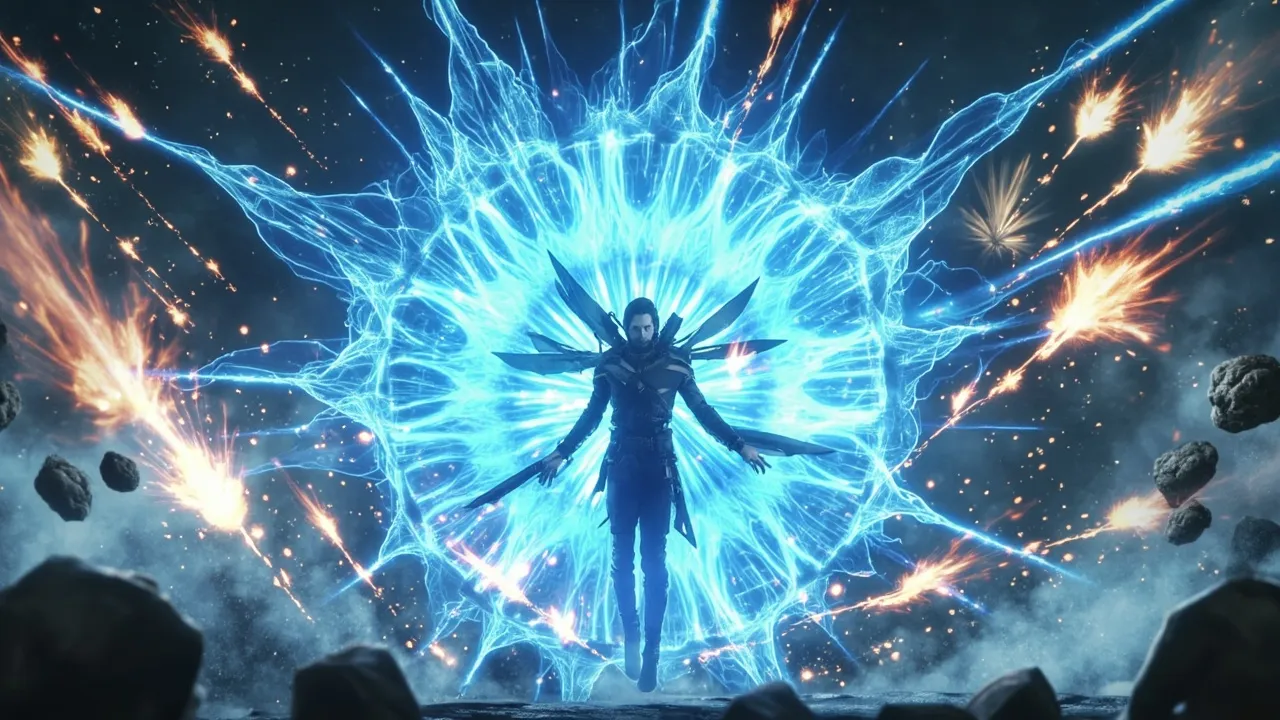Force Field Generation

Force Field Generation Video Demo 🎬
Table of Contents
- Force Field Generation Video Demo 🎬
- What Is Force Field Generation
- Core Abilities of Force Field Generation
- Application / Tactical Advantages in Combat
- Level: Level 1 🏙️, Level 2 🌇, Level 3 🌃
- Limitations of Using the Force Field Generation
- Weakness Against What Other Superpowers
- Synergistic Power Combos
- Known Users
Force Field Generation is the superpower of creating protective barriers—visible or invisible—that block damage, control environments, and shape combat. Users project energy shields, kinetic barriers, or psionic domes around themselves, allies, or zones to stop bullets, blasts, pressure, heat, or even mind attacks. In superhero teams, a reliable barrier creator is often the lynchpin for survival and battlefield control. For a broader look at other powers that pair well with this one, browse the superpower encyclopedia on the superpower wiki, or spark ideas using the random superpower generator.
What Is Force Field Generation
At its core, Force Field Generation lets a character produce a controlled, often semi-solid energy boundary that resists incoming forces. Depending on the source—psionic willpower, hard-light technology, gravity shaping, or raw energy manipulation—the barrier can be a bubble shield, a planar wall, a mobile dome, or complex geometric constructs. Advanced users reshape and layer shields, creating airtight pockets, reflective coatings, or pressure-diffusing membranes that make them near-impenetrable.
Key traits include:
-
Selective permeability: Let air and sound through while blocking projectiles, or vice versa.
-
Dynamic shaping: Mold a dome for defense, a wedge for ramming, or a ramp/bridge for traversal.
-
Energy modulation: Tune the barrier to disperse heat, absorb kinetic energy, or refract light.
-
Scale control: From palm-sized bucklers to city-block domes.
Core Abilities of Force Field Generation
Defensive Barriers
The signature move is an energy shield that absorbs or redirects harm. Variants include a personal bubble, team-wide domes, and phased screens positioned like walls. With practice, users can angle barriers to deflect blasts away from bystanders.
Kinetic Dampening
A kinetic barrier converts motion into harmless heat or disperses it over a larger area. This turns high-velocity rounds, shockwaves, and tackles into dull taps. It’s crucial against speedsters, explosive impacts, and falling damage.
Hard-Light Constructs
Some wielders produce tangible shapes—bridges, cages, wedges, battering rams—by “hardening” the force field. This blurs the line between shielding and construction, enabling quick cover, platforms, or environmental tools.
Containment and Crowd Control
A rapidly expanding dome traps foes, seals toxic spills, or quarantines hazards. Selective permeability allows oxygen in while blocking pathogens, gas, or sound, creating secure holding cells on the fly.
Reflection and Redirection
A polished or refractive surface can bounce lasers, redirect lightning arcs, or send concussive blasts back along their path. Skilled users fine-tune angle and curvature for precision ricochets.
Environmental Sealing
Airtight fields fend off vacuum, pressure, radiation, and extreme temperatures. Underwater or in space, a micro-atmosphere bubble keeps a team alive, with layered membranes regulating pressure differentials.
Force Amplification and Striking
By shaping a narrow wedge in motion, the user turns defense into offense—ramming through obstacles, tripping charging opponents, or concentrating pressure into a shield-bash that hits like a battering ram.
Sensory and Structural Feedback
Advanced users feel tension, pressure, and stress points across their shields, like a spider sensing tremors on its web. This feedback enables preemptive reinforcement where a hit will land.
Application / Tactical Advantages in Combat
-
Team Cover: Instant domes and walls buy time to evacuate civilians or regroup.
-
Line-of-Sight Control: Walls break an enemy sniper’s sightline or channel foes into choke points.
-
Hazard Management: Seal fires, acid, radiation, or biohazards while allies reposition.
-
Counterburst: Reflect blasts to force enemies into their own crossfire.
-
Mobility Support: Create ramps, steps, or sliding planes for rapid traversal and verticality.
-
Clash Neutralizer: Kinetic dampening undercuts brawlers, shield-bashing staggers them without overexposure.
-
Non-Lethal Takedown: Containment bubbles isolate dangerous targets while minimizing collateral damage.
-
Weathering Ultimates: Layered shields, offset in frequency, can survive multi-vector attacks long enough for a counterplay.
Level: Level 1 🏙️, Level 2 🌇, Level 3 🌃
Level 1 🏙️ — Novice Shieldbearer

-
Scope: Personal bubble or small wall; lasts seconds under fire.
-
Durability: Stops small-arms fire and low-level melee; struggles against explosives.
-
Control: Limited shaping; simple domes and flat planes.
-
Tactics: Defensive hold, brief cover while retreating, block-and-dash maneuvers.
-
Training focus: Endurance drills, basic selective permeability (air in, shrapnel out), quick-deploy practice.
Level 2 🌇 — Field Controller

-
Scope: Team-sized domes; multiple small barriers at once.
-
Durability: Withstands repeated blasts, moderate explosives, and brief superhuman strikes.
-
Control: Curved and angled surfaces for ricochet; selective permeability for gas and sound control.
-
Tactics: Corridor shaping, crowd containment, hazard sealing, ricochet counters, shield-bash offense.
-
Advancements: Begin hard-light constructs (ramps, wedges), layered membranes for heat and kinetic diffusion.
Level 3 🌃 — Master Architect

-
Scope: City-block domes, multi-layered grids, and complex hard-light constructs.
-
Durability: Absorbs or redirects heavy ordnance, beam weapons, and sustained superhuman impacts.
-
Control: Precision reflection, pressure regulation, micro-atmosphere bubbles, dynamic reconfiguration in combat.
-
Tactics: Simultaneous defense, mobility infrastructure, and battlefield sculpting; real-time countergeometry against wide-area attacks.
-
Signature: “Harmonic stacks”—offset barrier frequencies that stagger incoming multi-type damage (kinetic, thermal, EM) and prevent single-point failure.
Limitations of Using the Force Field Generation
-
Energy Drain: Large domes, continuous dampening, and hard-light constructs burn stamina or power reserves fast. Marathon defense risks collapse at the worst moment.
-
Focus Dependency: Complex shaping and selective permeability require concentration; surprise attacks during reconfiguration can slip through.
-
Coverage vs. Strength Tradeoff: The bigger the barrier, the thinner its distribution—massive domes are vulnerable to focused strikes.
-
Frequency Mismatch: A barrier tuned for kinetic impacts may underperform against thermal or EM attacks unless the user can modulate quickly.
-
Anchoring Issues: Free-floating fields can be shoved or rolled by colossal forces; anchoring to terrain solves this but reduces mobility.
-
Internal Threats: Anything already inside the dome—explosions, sonic bursts, gas—becomes the user’s problem unless selective permeability is expertly set.
-
Line-of-Sight Constraints: Some users must see the area they’re protecting; blind spots or obscurants hinder placement.
-
Feedback Overload: Sensory feedback can become painful when multiple layers are struck simultaneously, disrupting control.
Weakness Against What Other Superpowers
-
Vibration and Sonic Manipulation: Resonant frequencies can destabilize rigid shields, causing cracks or sympathetic failure.
-
Phase/Intangibility: Phasing powers bypass most barriers unless the user adds specialized phase-lock fields.
-
Reality Warping and Magic Overwrites: Rules-breaking powers thread around physics-based defenses unless the barrier is anchored to conceptual or arcane frameworks.
-
Disintegration/Corrosion Fields: Persistent, field-wide erosion forces constant regeneration, exhausting the user.
-
Gravity Distortion: Extreme shear or tidal forces can twist anchor points apart, prying open seams in large domes.
-
Teleportation Inside Perimeter: Bypasses exterior strength entirely; countermeasures require anti-teleport matrices or internal sub-shields.
-
EMP and Power Nullification: Tech-based shield projectors fail under EMP; psionic or bio-energetic users may falter in null zones.
Synergistic Power Combos
-
Telekinesis + Force Field Generation: Use fields for bulk defense; telekinesis for precision catches and internal pressure control—together they form versatile offense/defense cycles.
-
Energy Absorption: Convert incoming fire into battery charge, then route that energy to strengthen the next barrier or power a counterstrike.
-
Gravity Control: Anchor domes with micro-singular “stakes,” resist shear forces, and compress shockwaves for safer dissipation.
-
Cryokinesis or Pyrokinesis: Temperature-tuned membranes boost environmental control—freeze projectiles mid-flight or vent heat harmlessly skyward.
-
Illusion Casting: Hide barrier seams or create phantom gaps to funnel enemies into traps.
-
Speedster Support: Drop instant ramps and cover for blitz tactics; tune permeability so allies pass through while enemies slam into a wall.
-
Healing or Regeneration: Sustained defense lets healers stabilize allies mid-fight, turning attrition battles in the team’s favor.
-
Technopathic Integration: Smart shields auto-adjust to attack signatures, log threat telemetry, and reconfigure harmonics in milliseconds.
Known Users
-
Susan Storm Richards (Invisible Woman) — benchmark for versatile, fine-control force fields with offensive constructs and airtight domes. Learn more about the character via the Marvel profile.
-
Violet Parr — notable cinematic example demonstrating personal bubbles, projectile blocking, and team domes; see the Pixar Wiki.
-
Jean Grey — telekinetic barriers as battlefield deflectors and containment; classic case of psionic shielding with finesse.
-
Doctor Strange — magical shields and sigils illustrating arcane variants of barrier projection.
-
Green Lantern Corps — hard-light constructs and protective auras, showcasing the construct-building end of the spectrum.
By understanding Force Field Generation—its defensive core, shaping techniques, tactical uses, and natural counters—creators and players can design balanced characters and more dynamic encounters. Explore more entries in the superpower wiki or randomize an idea with the generator to discover powers that combine brilliantly with barrier creation.
